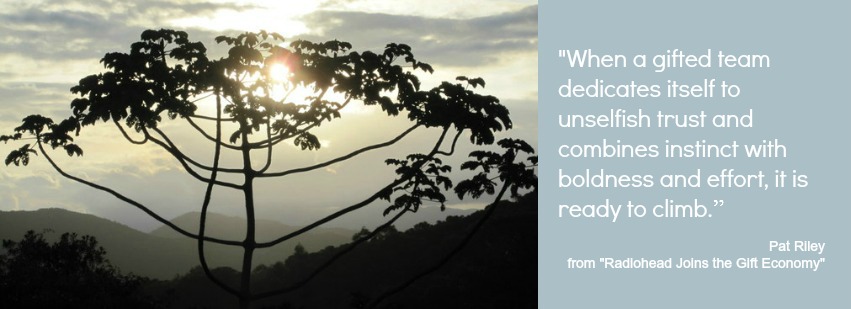Just Say “No” to Icebreakers

Over the last few months, I’ve had many opportunities to work with a variety of teams and I’m beginning to get a sense of some overarching “things to do” to ensure a stronger unified team. In the past, I’ve been well aware of the need to create comfort for the group early in the game. Sometimes I have the group generate their own guidelines. Sometimes I do interviews with some of the people ahead of time. Sometimes I use my standard icebreakers. On a good day, I will get creative and try out a brand new icebreaker but all of these seem a little like piecemeal techniques. What I do know and have always practiced is not to randomly use icebreakers for any group especially when they have asked me to include some teambuilding. I actually get quite annoyed as a participant when I’m asked to do an icebreaker by the facilitator that seems to have nothing to do with the topic or the group’s needs. We are not saying never to use icebreakers but rather we are saying there is a complex weaving of activities and tone setting that makes teambuilding extremely effective.
What if we had a conversation about this and collectively as a group of skilled facilitators shared our ideas about how to systematically strengthen teams? We may decide to include carefully chosen icebreakers or energizers are part of the agenda but likely they are one of the least important things. So right now I’m going to start the conversation and give you 5 things you do BEFORE the event and 5 things DURING the event to strengthen teams. For myself, this has been a good exercise to ensure that I will always do these 10 things from now on – this will be my starter tried and true list. Please help me refine this list.
Before the Event
1. Set up at least two longer conversations to design a relevant custom agenda with the key client members. Ideally this will include not only person who “hired” you but also a few other participants who will be attending the event.really dig deep with this small group and ask them provocative questions that get them thinking about why they are doing this.
2. If you cannot get some of the participants to be on some of these agenda design conversations, ask to interview 3-5 of the participants who have widely diverging perspectives on the topic at hand. Craft a good set of questions that help them feel safe with you and the event but also give you good context for refining an agenda that will truly strengthen and unify the team.
3. Ensure the written agenda goes out to the group 5-7 days in advance of the event and it includes clear objectives for the event and some of the key questions you will ask them. Use language that is positive but acknowledges the challenges that may be present. Invite them to contact you at any point before the event.
4. Ideally, as written about in a previous blog, find a skilled co-facilitator who has the right skills and attitudes for this particular group. prepare ahead of time by writing out your opening words of context -setting. Create a detailed facilitator’s guide and know who is doing what. Talk about how to support one another before you start.
5. Set up the room to reflect your “extreme care” of the team’s time together. You may want them to start in a circle of chairs without the barrier of tables in front of them. This suggests that you are going to do some deep work together. You may also wish to have a poster of group guidelines at the front of the room so they know you will be covering that. And finally, it is really helpful to have colorfully decorated tables – clothes, toys, flowers, markers, stickers, name tags, etc.
During the Event
1. Acknowledge up front why you are there, your role as facilitator (or as co-facilitators) and your ability to be flexible and shift the agenda if their needs change during the day.
2. Design a positive teambuilder/icebreaker that will work for this particular group. The purpose of this initial meeting starter is to set a positive tone but not be trite or silly. I just bought a book last year from the IAF Conference called “Quick Meeting Openers for Busy Managers” by Brian Cole Miller, 2008. There are many books on the market and items on the internet to help you find exactly type of teambuilding starting activity. One easy one is to have everybody share one thing they love about the team or the project they are working on. Remember to be very careful about your choice of team-builder. Test it with your design group or a few participants ahead of time to ensure they find it helpful. Tell people why you are doing this ice-breaker, how long it will take and then be sure to “debrief it”. Or, just don’t do an ice-breaker. It is not that helpful if you do everything else right.

4. Keep mixing people up throughout the day by putting them in different small groups. Sometimes we think we should not put a certain person in with a different other certain person 🙂 As long as you keep moving people around, it is OK for those who have interpersonal conflict with each other to have a short period of time with each other in the safety of a somewhat larger group. This starts to reduce the tension and discomfort of having these people together. Tip: Keep your groups to at least 4 people if you suspect there are many interpersonal conflicts. (Then there is a buffer of least two other people and the two in conflict have to be polite to each other because they are with others).
5. Give group members an opportunity to decide if they need to change the agenda towards the end of the day. We find for example that our agendas are generally too ambitious and at the last hour we may find we still have 3 or 4 agenda items that we had intended to cover. It is a great practice to review what is left on the agenda with the group and then ask the group “which of these are most important and which could we leave for another time?”.
In the end what you’re aiming for is Patrick Lencioni’s five attributes of highly functioning teams. See his book The Five Dysfunctions of a Team, 2002:
- People trust one another
- Participants are able to engage in unfiltered conflict around ideas
- The group members are willing to commit to decisions and plans of action
- Everyone holds one another accountable for delivery of the plans
- There’s an overall focus on achievement of collective results

Final Tip
Creating safety is key to people trusting each other. People will not feel safe if they are not able to speak without being “attacked”, there is fear of retribution, or if there are some people allowed to dominate over others. Dale Hunter, a New Zealand facilitator, has a great chapter on safety and trust in her book called, “The Art of Facilitation: The Essentials for Leading Great Meetings and Creating Group Synergy”, 2009.

In our Meetings That Rock virtual course this morning, participants repeatedly mentioned that they had been impressed with the “Three C Rule” that we had shared with them at the beginning of the course:
- First, create Comfort – make sure people do not enter the meeting room in their reptilian brains which is about fight, flight, freeze, etc.
- Then, create Context – repeatedly tell people what you are going to do and how you are going to do it and invite them to add or change the process throughout the time they are together with you.
- Finally, introduce Content – i.e. only after Comfort and Context are established.
And for your fun entertainment, we leave you with this fun video clip, The Power of Union in Strength. My dear colleague, Marem Flores found this for us. She is a great gifted and creative facilitator herself!


